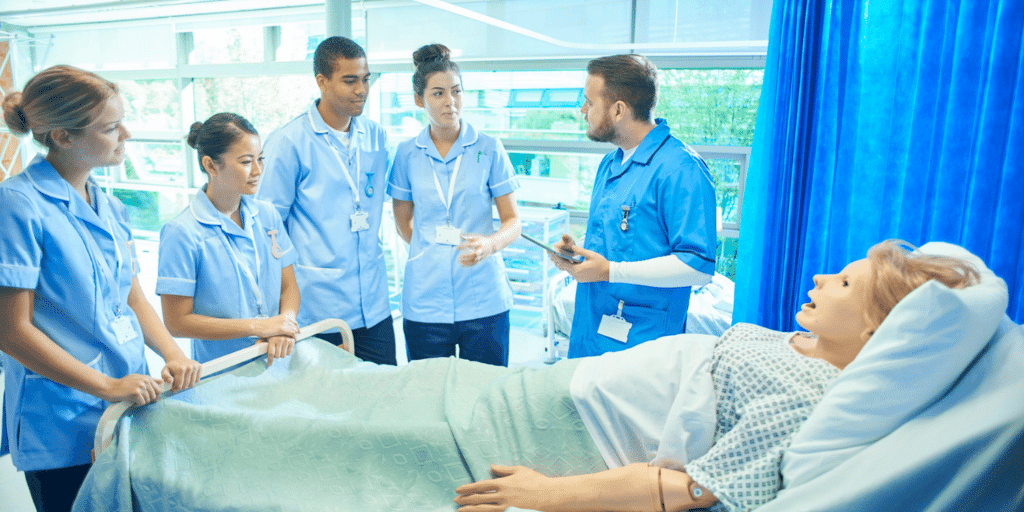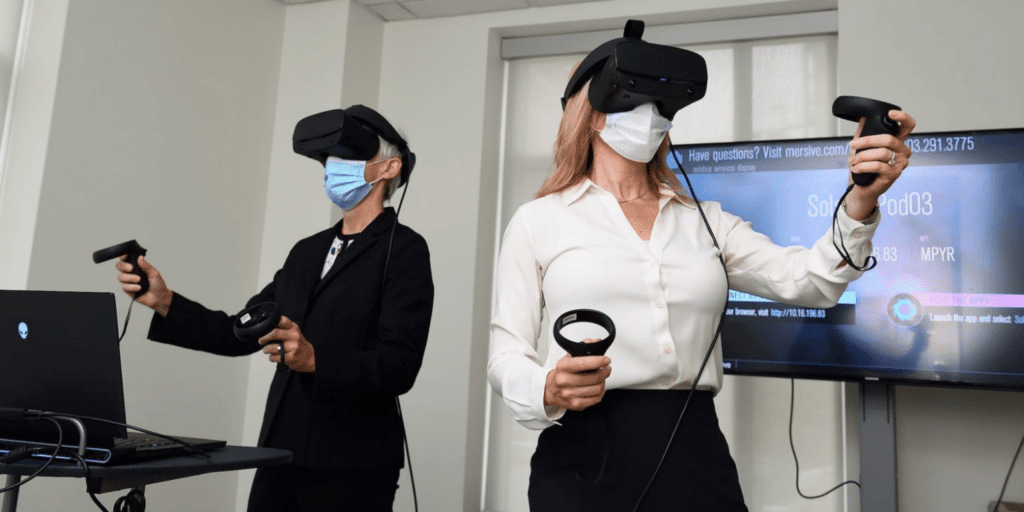Developments in healthcare technology are now more exciting than ever. With increasing pressure on health services, it’s now crucial to use emerging technologies to support staff, reduce human error, and improve patient outcomes.
Enter XR — a group of technologies, first seen in gaming and education, that are now shaking up all aspects of healthcare.
With the global healthcare market for XR estimated to reach $4.6bn in the US alone by 2025, XR is a game-changer for healthcare systems — and there are surprising possibilities for its use in training, recruitment, and beyond!
What is XR?
XR — or Extended Reality — is an umbrella term for all immersive technologies, including virtual reality (VR), augmented reality (AR), and mixed reality (MR). These all “extend” our reality by blending the real world with computer-generated elements or by creating an entirely immersive virtual experience.
Virtual reality (VR) is arguably the most well-known of all XR technologies. Using a Head-Mounted Device (HMD), like the Meta Quest 2 or Pico Neo 3, users receive a completely immersive experience. This experience can be simple, like a 360° video of a real-life setting, or a completely interactive, adaptive virtual environment.
What are the uses of VR in healthcare? There are plenty! On the educational side, platforms such as OMS can deliver virtual clinical experiences to healthcare students and practicing clinicians alike. Were OMS focuses on training for nurses and physicians, other virtual reality platforms serve procedural training for surgeons. Beyond that, VR has direct applications to patient care, such as gamifying physical therapy sessions to speed up recovery times, and using immersive, controlled scenarios to improve outcomes in mental health patients.
Augmented reality (AR) superimposes computer-generated content over what you see in the real world and is used mainly with phone apps and smart glasses. Though it doesn’t offer the total immersion of virtual reality, AR is a valuable tool for overlaying additional information in a real-world environment.
Augmented reality offers some fantastic benefits to healthcare training and patient care. For example, institutions have leveraged AR to improve the success rate of intravenous injection by mapping vein structures onto the surface of a patient’s skin.
Mixed reality (MR) has similarities to augmented reality in that a device projects computer-generated content over the real world. The fundamental difference is that mixed reality content is responsive and spatially aware. For example, a ball dropped in MR could bounce when it hits an object in your space, making the experience more interactive.
In healthcare, mixed reality can extend the impact of more limited training equipment. One application uses MR to provide dynamic feedback on low-fidelity manikins, which helps to maximize manikin functionality and significantly improves learning outcomes.

What benefits does XR offer over physical training?
XR revolutionizes the traditional approach to healthcare training. Where learners would previously have only had occasional opportunities to practice on manikins, they can now practice whenever and wherever they need with virtual patients in adaptive VR scenarios.
This allows trainees and practitioners alike to practice safely, developing their skills and confidence in a lifelike environment, with improved learner outcomes.
The most exciting part about XR technologies in healthcare training? They require fewer resources, reach more learners, and can provide feedback on improvement over time — helping you prove that you’re getting a return on your investment.
Fewer resources
Hands-on experience with real patients is an invaluable way for healthcare trainees and professionals to develop their skills — but it comes with the added risk of putting patients’ lives in danger. Manikin-based simulation was designed to bridge this gap, allowing students to learn from their mistakes safely.
Sadly, there are still drawbacks to this method of training. To anyone familiar with physical simulation, it should come as no surprise that the setup is expensive and resource-intensive. In addition, the equipment requires considerable space, ongoing maintenance, and dedicated faculty to run every session. XR platforms differ in that they’re relatively inexpensive, require a fraction of the space, and many require little-to-no external supervision once configured. Virtual reality allows you to create multiple environments using the same platform — such as maternity labs and outpatient clinics — helping you deliver outstanding healthcare education to as many learners as possible.
More scalable
Because of physical simulation’s resource constraints, scaling up operations to meet demand is rarely workable. Institutions don’t always have the time, money, or faculty needed to give learners on-demand access to the training they need. The good news is that these obstacles don’t apply to XR, so you can facilitate truly flexible learning. Cost-savings, portability, and the possibility of unsupervised practice mean that users can train anywhere, at any time, repeating simulations as often as needed to hone their skills.
Better feedback
Even the best technician will find it impossible to operate a scenario exactly the same way consistently, which makes it challenging to measure cohort performance. Additionally, the debriefing process is rarely recorded, and learners can’t effectively benchmark their efforts. On the other hand, standardized XR platforms give the same experience to each user every time without fail. Even better, platforms like OMS use advanced analytics, so users can track their improvement over time and understand how to improve.
How can XR be used besides education?
We’ve explored why XR is an ideal medium to supplement physical simulation and education in healthcare. Still, there are so many other ways that technology is useful in healthcare. This is especially true of virtual reality.
Ongoing training
Learning shouldn’t stop when students graduate. Up to 57% of new RNs leave their roles because of an inability to ensure patient safety, and a lack of ongoing training plays a key role. The portable, scalable nature of XR lends perfectly to solving this dilemma. Users are free to brush up on existing skills — and learn new ones — in a safe context before transferring their learning to actual patients. A vast library of scenarios with VR means a wide range of staff can access tailored learning opportunities. The flexibility of the tech also means that busy doctors and nurses can fit in training around their hectic schedules without too much prior scheduling.
Recruiting staff
With up to $250,000 invested in a single physician candidate (and around $82,000 for a nurse), hiring the right person for the job is vital. This makes virtual reality an ideal medium for hiring managers. It can help remove bias, test skills in a standardized environment, and impress top candidates by using innovative tech to show that institutions are willing to invest in staff development.
Improving staff retention
The average US hospital has turned over 80% of its RN workforce in the last five years, and annual physician relocation rates sit at around 11–18%. Healthcare institutions must invest in their workforce to promote a happier, more engaged culture. Integrating novel technologies (such as XR) into training programs can encourage job satisfaction, and analytics feedback from platforms such as OMS can help faculty identify who needs extra support. Virtual reality is also great at expanding user perspectives, which can be crucial for reducing interprofessional barriers and encouraging collaborative environments.
Improving remediation of healthcare professionals
In healthcare, ensuring patient safety is vital, so staff underperformance is a cause for concern. The problem is this: remediation programs lack uniformity, and there’s little research to suggest whether outcomes are successful. XR can help to change this by providing standardized training that easily integrates into remediation programs. Some platforms even offer detailed analytical feedback to suggest whether staff are genuinely making progress. Even better, tracking performance in this way can help to catch issues early so that institutions can proactively address concerns before patients are exposed to potential harm.
Summary
Extended reality is at the forefront of the new, exciting innovations in healthcare. It’s widely acknowledged as a formidable tool for its educational applications, but there is so much more to what AR, MR, and VR can offer.
As champions of virtual reality healthcare simulation, we’re particularly excited about the possibilities that VR provides in training competent nurses and physicians, hiring the best candidates, encouraging retention in valued employees, and supporting healthcare professionals to practice safely and elevate their performance.
